Monday, 5 July 1999
Irbid, Jordan
We have gained a lot of experience in border crossings over the months and know that smuggling is a kind of side line for the inhabitants of the towns either side of the border. However at the Dara'a-Ramtha border it is the ferrying of people which is the side line to the industry of smuggling. In fact it appears that having a couple of foreigners in the back of your car makes it more likely that you will get through. All the taxi drivers own very beaten up, huge American cars like Chevrolets and we soon found out why. Our driver had basically ripped out the ventilation system of his car and by removing the vent grill could stash four boxes of two hundred cigarettes behind he dashboard. For some unknown reason he took them out before the Jordanian border and put them underneath the front seats. Naturally the guy checking at the border found them. In fact the check was amazingly thorough, the back seat was completely removed. The second reason you used a beaten up car became clear, they are easier to take apart and you don't care so much when the seats are ripped out, turned upside down and then thrown casually back in. I am not sure if our driver had to pay a fine, the boxes seemed within the limits for three people - but on the other and he did seem slightly pissed off.
From Ramtha we caught a bus to Irbid a hip university town in the north of Jordan. From the minute we arrived everything seemed a lot easier in Jordan, everyone wants to help you to the point where you are waiting to cross the road and someone will ask you "where are you going?". More than this although everything is very honest in Syria, you are more likely to get ripped off in London than you are in Damascus, there are always a few people, taxi drivers especially, who try it on. In Jordan however everyone is very straight, taxi drivers often as not use their meters and you never seem to get charged more than the locals for anything. This could all be a cunning deception but I think that it is much more likely that the Jordanians are one of the most friendly, honest bunch of people you are likely to meet.
Tuesday, 6 July 1999
Irbid, Jordan
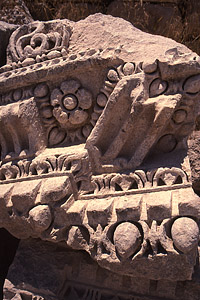
(Jerash, Jordan)
We had decided to use Irbid as a base to visit two or three different sites. First and most well known of these was Jerash . One of the Decapolis ("Ten cities") Gerasa, as it was then known, was a thriving town with a great deal of autonomy from the Roman Empire. In its golden age many public monuments and buildings were constructed and a lot of these survive to this day.
The site is pretty big and the first thing we did was to walk the long stretch down to Hadrian's arch, an archway which would have been at the southernmost limit of the town if the town had not gone into decline shortly after its construction. Beside the road was the remains of the hippodrome which seemed to be in the process of being reconstructed. However the more we looked at it the more we saw that it was actually being rebuilt. Stone masons worked under shades chipping at sandstone to make the blocks which were gradually being fitted to form the arches at one end of the 15,000 seater stadium. We looked around for a while and then headed back towards the main part of the city.
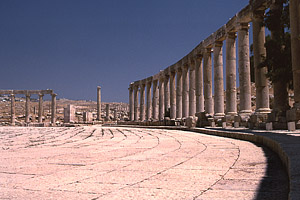
(Jerash, Jordan)
At the start of the Cardo Maximus a huge oval plaza was built. It is one of the best examples of how well the ancients understood the aesthetics of various shapes much better than modern tow planners. The colonnade sweeps around on either side of you and the paving stones beautifully follow this curve. It was a great place to sit for a few minutes and whilst we did we were able to watch some temporary buildings for the Jerash music festival being dumped into place in the middle of the plaza presumably because they knew that I wanted to take a panoramic photograph of the entire sweep. We climbed a small hill above the plaza to take a look at the temple of Zeus. Its huge pillars had toppled over in an earthquake and lay scattered all over what would have once been a staircase leading up to the temple. I started wondering how long it would be before someone started to think about picking them up and putting them back in place.
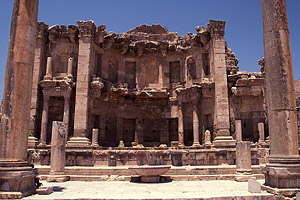
(Jerash, Jordan)
We descended back to the plaza via one of Jeash's two theatres then exited via the Cardo Maximus. The Cardo is full of character its paving slabs uneven and worn by the wheels of countless carts. The pillars of the colonnade were upgraded to the Corinthian order at some point and as it slopes gently uphill they gradually decrease in height. Apart from a few shops and some interesting low level niches by the side of the cardo the next big feature is the nyphaeum, a public fountain dedicated to the water nymphs. This has survived the years pretty well or else was put back together quite well. Its various niches would have housed statues pouring the water into a series of highly decorative sinks. A huge red granite bowl is give pride of place despite the fact that it was probably a later addition. It somewhat dwarfs a sink carved with four little fish kissing.
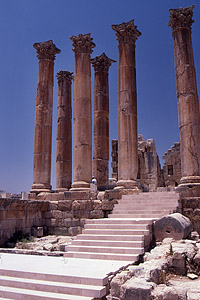
(Jerash, Jordan)
Next to the nyphaeum a staircase rises to the temple of Artemis. Unfortunately we were denied the full effect by a temporary stage which was borrowing the staircase as a seating area. We walked through the scaffolding and found ourselves in the temple. Little of the outer structure has survived but the Cella and its bronze coloured columns are still standing. The columns demonstrate that it was not only the Incas that understood how to build earthquake proof structures. The segments of the column are designed to wobble and apparently wave gently in the breeze, not that we could observe this minute effect.
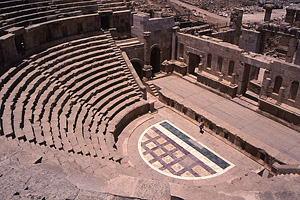
(Jerash, Jordan)
After the temple we found the second theatre. It had been nicely restored and even sported a tasteful floor design. Sadly however it was the last in a long series of theatres so we did not spend too much time looking around. We then returned to the cardo and found more rebuilding work going on in the form of a gateway beside the western bath house. On one level it was pretty interesting to watch the work being carried out in pretty much the same way as it had been done centuries ago. On another level I thought it was a bit bizarre. It is nice to reassemble and restore the theatres to produce a venue for a festival. But then to go on to transform the whole place into a new ruin? I am not so sure, but then we like wandering round the fallen pillars and finding overgrown carvings.
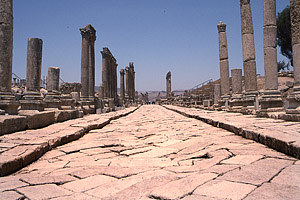
(Jerash, Jordan)
Back in Irbid we continued getting into the Arabic sleeping regime. It takes some getting used to and is not wholly appropriate to tourism but it certainly beats walking around in the midday heat. Temperatures these day were consistently bordering on the forties but the mornings are always crisply cold. Later on we went out for dinner and ice cream. We had what can only be described as a monster kebab. About a metre long and cut up into more manageable chunks it was very filling.
Wednesday, 7 July 1999
Irbid, Jordan
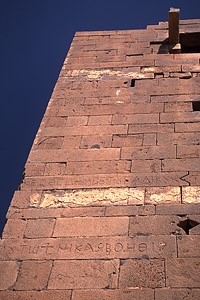
(Umm el-Jimal, Irbid, Jordan)
We had planned not to do the circuit of "Desert Forts" which most people go for and decided to limit our exploration of the desert to as single trip to the ruins of Umm el-Jimal . We were a bit worried since the town is very close to Bosra and built out of the same basalt of the Hauran. However after a total of three buses, a truck and one puncture we were dropped off at a site that definitely was not inhabited and not covered in litter. More than this it was free which surprised us because there was in fact a tourist office and a small faux-bedouin tent cafe.
The site looks like a bit of a nightmare from a distance but once you get into it the details slowly materialise. The barracks sported a tower carved with "EN TOUTO NIKA" the battle cry of the Emperor Constantine. We found a small church and just past it an amazing building known as the Sheikh's House. Here some of the unique design features of the town are at their clearest. The doorways have a small window over the top of them in order to spread the load more evenly. We even saw a lintel which had cracked because of the lack of such a window. The staircases consisted of a series of triangular blocks built into the wall, one side forming the staircase the other a smooth diagonal surface. Naughtily I even climbed to the top of one so that Anna could take a picture. The doorways in the past sported huge basalt doors. Although we only found one door still in place we found plenty of the sockets in which the pin of the door was located.
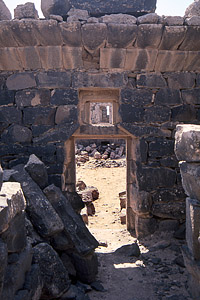
(Umm el-Jimal, Irbid, Jordan)
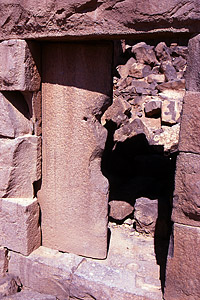
(Umm el-Jimal, Irbid, Jordan)
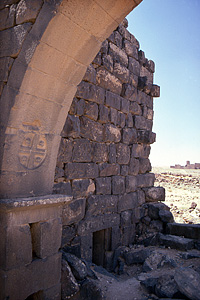
(Umm el-Jimal, Irbid, Jordan)
We must have been rooting around the buildings for at least a couple of hours and we probably explored only a fraction of them. After eating our packed lunch of falafel sandwiches we went back to the tourist office to wait for a bus. The cafe owner asked us inside his tent and so we bought a couple of cokes from him and started chatting to him and the tourist information chap. It seemed weird to us that here there was a guy sitting in an office in the middle of nowhere for a site which is free to get into but it became clear that he was not only well educated but also well paid to do so. We spoke to them for about half an hour and when it was time to leave they came to the side of the road with us to find us a lift.
The lift they found for us turned into quite an experience. It was a pick-up driven by a Bedouin who used to be a colonel in the army but had now retired to a life of farming. He gave us quite a talk on how everything was different now how Israel were enemies once but now were friends, how there were no more terrorists in Jordan and no more "ugly Islam". He kept on telling us how he loved Britain and the USA and that Britain apparently was known as the "wise old woman" - quite amazingly since it was Britain's duplicities and boundary drawing exploits which caused a lot of Jordan's problems in the first place. To some it may have seemed that he had swallowed the official line a bit too much but I felt that this sort of unconditional forgiveness was the only way ahead in terms of a peace settlement for the middle east. That week the new Israeli Prime Minister was flying around all of the countries of the Middle East to broker a peace deal. If all the people he met with were to take the same stance as this colonel then an end would be in sight.
Thursday, 8 July 1999
Umm Qais, Irbid, Jordan
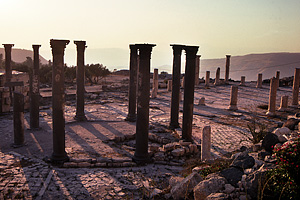
(Umm Qais, Irbid, Jordan)
We had managed to get a bit bored of city life and decided that rather than doing the customary day trip to Umm Qais that we would stay the night there and then go to Amman the day after. We arrived around ten in the morning and had to wake up the owner of the town's only hotel in order to get a room. We then went shopping which did not take long as the bakery and the grocery were both under our hotel and the supermarket opposite. We then strode off hopefully in the direction of the ruins.
Umm Qais, then called Gadara, was another of the Decapolis. It was a pretty big place but all this was lost when it was reoccupied and the stones reused to build a small Ottaman village the occupants of which were moved out by the Government at the start of the eighties. Thankfully however we were not relying solely on the ruins to entertain us - as you can imagine we were getting a bit bored of Roman towns by now - we also had the view. Umm Qhays is situated on a hill which overlooks the Sea of Galilee and is overlooked by the Golan Heights on the other side of the river Yarmouk.
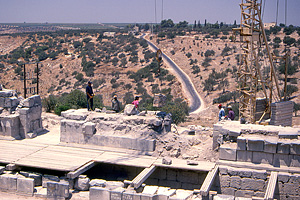
(Umm Qais, Irbid, Jordan)
We walked through the Ottoman village which was quite picturesque, if you ignored the fact that it was gradually falling apart, and emerged at the terrace of the restaurant. It was true that there was quite a view, the problem was that it was so hazy that from where we were the Sea of Galilee was little more than a vague outline. We decided it would get a bit better as the day went on and went to have a look around the ruins instead. By far the most interesting thing going on was the fact that one of Umm Qhays' two theatres was in the process of being restored. A female German archaeologist and a small team of Jordanians were using a crane to remove blocks that had tumbled down onto the stage during the earthquake which had basically ended Gadara's golden era. We sat and watched as one by one stones were lifted out and placed in a huge array on the slopes of the hill below awaiting re assembly. It was fascinating as we failed to see how the jigsaw puzzle would ever be put together. We had realised from seeing similar arrays of stones at many other sites that some of the pieces of the puzzle would never be put back into place.
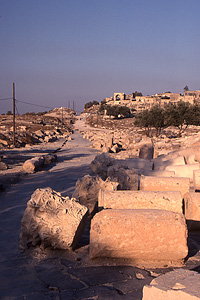
(Umm Qais, Irbid, Jordan)
The black basalt Cardo Maximus was in perfect condition and had been cleared for over 500m of its length. We walked along it and finally got to the circular foundations of a tower besides which some stairs led down into a mausoleum. It was a pretty impressive piece of work and we were latter to see the finely carved basalt doors, the sarcophagi and the mosaics that had been removed from it in the site museum. In a way I felt it was sad that all these trappings had been relocated as they were hardly better protected in the museum. Just after this the Cardo disappeared under the soil so we decided to wander off through the olive trees to find somewhere to eat lunch. We picked a shady spot with a view of the Sea of Galilee and chomped through our sandwiches.
The other survivor of the earthquake was the Basilica terrace, a small square over a row of vaulted shops which once sported a basalt church of which the only remains are an octagonal set of basalt pillars and some floor tiles. This occupied us for a few minutes before we retired to the restaurant for some very expensive cokes which we nursed for at least part of the two hours that we spent writing our diaries and waiting for the Sea of Galilee to appear. We returned around sunset for dinner and by this time the mist had cleared just enough and the sun was just at the right angle for us to make out the lakeshore city of Tiberius in Israel. We sat down for dinner as the sun slowly set producing the most spectacular reds and yellows I had seen in a while. As it got darker it became easier to make out the light of more towns in Israel and in the occupied Golan heights. It was quite an interesting feeling to be able to spy on another country over such a highly disputed border. We were not the only ones enjoying the view however, a few Palestinian families had also made the trip to see sunset over the area they had been evicted from not so long ago.
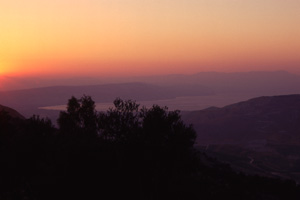
(Umm Qais, Irbid, Jordan)
We had come to Umm Qhays to escape from the noise of the city, sadly we had not realised that Thursday night was the Islamic equivalent of Friday night and of course Friday night is party night. Sadly the nearest Umm Qhays' had to a disco was the section of road just outside our hotel. The noise did not stop until about one and we were able to sleep until the call to prayer kicked in sometime between four and five closely followed by the baker pounding dough in his shop below us. We were understandably a bit tired and irritable the whole of the next day as a result.
Friday, 9 July 1999
Amman, Jordan
We left Umm Qais pretty early and reached Amman via Irbid around eleven. We checked into the Cliff Hotel and then made a beeline for a place called "Books@Cafe" to get lunch and a much needed injection of new reading material. It turned out to be a hip sort of joint that would not have looked out of place in Hampstead, unluckily neither would have the prices but my spinach and cheese crepe made a nice break from our kebab and pizza diet. We did a bit of surfing and spent hours deliberating over books, eventually unearthing a second hand copy of "Captain Corelli's Mandolin". We were seriously malingering but then there was not much for us to do. Amman boasts a huge theatre which we could not face and all the shops were shut. Continuing in the same vein we then took a service half way across town to the best ice cream parlour in Amman then a taxi the rest of the way, to the Rovers' Return.
Okay it is a bit pathetic to go on holiday and then knock yourself out to get to a Coronation St theme pub but when you are in a 94% Muslim country in 40ºC temperatures you grab any chance to savour a nice cool beer you can. We walked through the door and were amazed to find that although the streets of Amman at seven o'clock were pretty deserted inside the Rovers' Return they were doing a brisk trade. We had just missed happy hour and by the look of the line of male ex-pats at the bar the object of happy hour was to get as many pints in as possible. This was highly forgivable considering that a pint of Amstel sets you back £2.50 in Amman. We sat down at a table and got a menu. The first page of it was a list of quotes from Coronation Street most of them taken from the Ena Sharples era but I did spot the more recent "There's always something up when Jack [Duckworth]'s around and it isn't the takings". As I tucked into my fish and chips I wondered what your average young Jordanian professional would make of it all (and believe me they flocked to the place later on). We followed up by going to the Irish pub and chatting to some American Peace Corp workers then dancing until one.
Saturday, 10 July 1999
Madaba, Jordan
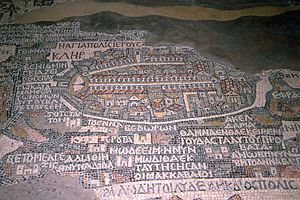
(Madaba, Jordan)
Very hung over we realised that we were not going to be in Madaba until the afternoon. When the pounding hammers stage was over but before the feeling nauseous stage had set in we went out to find a book about walking in Wadi Rum then had a superb Fuul and Hummus breakfast at the restaurant over the street from our hotel. The place is pretty famous for these dishes and its all they serve washed down with a tea from a passing waiter yelling "Shy, Shebab" the Arabic equivalent of "more tea vicar?".
Getting to Madaba was pretty easy and once we were there we walked trough town to Lulu's Pension. It was an absolutely lovely hotel if a bit on the expensive side for our pockets but we needed a change from the usual flea pits. We then decided it was once again time for a siesta and retired to our bedroom until four to sleep the later stages of our hangovers off. We then went off to look at Madaba's famous map mosaic and see what all the fuss was about.
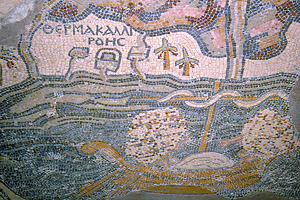
(Madaba, Jordan)
Well it was pretty impressive despite the fact that only half of the originally huge 15.6x6m mosaic depicting the Levant has survived. Fortunately the bit that has survived covers the Dead Sea and Jerusalem and some bits of Jordan. The mosaicists went to enormous pains to make the map a true topographical representation and if you excuse Egypt being bent round so that the Nile runs in the wrong direction and is seemingly due south of Jordan they did a pretty good job. The street map of Jerusalem is apparently pretty accurate and contains several recognizable buildings. The Dead Sea sits slap in the middle of the surviving portion and features two chaps in a boat with what possibly is a pile of salt between them. In between the cities the map is filled with colourful details of animals and very strange coloured patches which are either hills or fields.
After looking at the mosaic from all possible angles and taking photographs we decided to make for another set of mosaics in what was called the archaeological park. Sadly it was closing at five which was about five minutes after we arrived so we decided to give it a miss. Instead we went back to the hotel to do even more chilling out. On the way in we met one of the leaders of a large group of Canadian archaeology students that were occupying ninety percent of the hotel's rooms. She told us a bit about their dig. Whilst she was talking I got to thinking about the times of the day when it would be cool enough to be digging and did not like my conclusions. I asked what time they usually set-off. "five o'clock", I could see we were not going to be lucky in the sleep department. Fortunately that evening we found out that staying out until one in the morning in Madaba is not really possible and we got to bed around ten.
Sunday, 11 July 1999
Madaba, Jordan
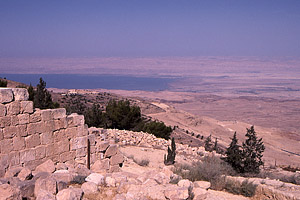
(Mount Nebo, Madaba, Jordan)
Going to sleep at a time which has not been your bed time since you were six yeasr old has its distinct advantages. One is that when a group of archaeologists find out that their bus driver has slept in and decide to wait for him right outside your window from five to six thirty you do get so upset. I will not go into the petty ins and outs of the situation but the archaeologists were due to stay in the hotel for three months and so had turned it into a student dorm with such thoroughness that fridge warfare had nearly reached the labelling stage. Anyway there were only two other rooms free and I think they saw any tourists as invaders in their home. To be fair living in a hotel for three months is a bitch, I know because I have done it. This however did not stop me from seriously wanting to shout out of the window at them to shut up.
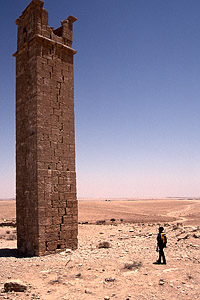
(Umm ar-Rasas, Madaba, Jordan)
From Madaba it is a short bus journey plus a twenty minute walk to Mount Nebo . This is a much better transport arrangement than in Moses' day when it was a very long walk from Egypt even if you knock off a few days for time spent chilling out in the wilderness. We got there about nine and pretty much our first reaction was that we had got on the wrong bus. There was no colossal volcanic cone in sight. In fact we were so unsure of where we were we ended up believing a taxi driver that the mountain was 10km away rather than the 2km that our book said. Of course our book was right. It was not until we got on the terrace of the monastery that we started digging the Moses connection. The view of the northern end of the Red Sea and the Jordan valley was spectacular. Mount Nebo was not some monster peak it was just a small hill on the edge of a very high plateau above the Dead Sea. Maybe from the lakeside it would appear to be a colossal peak but from the Madaba road it just looked like a bump.
Inside the church it was a veritable mosaic-fest. Again they had suffered a bit with time and at the hands of iconoclasts but they still told their story. It is a shame in a lot of ways that people do not make mosaics anymore. As well as lasting practically forever they are also very permanent in a physical sense. They are designed for a given building and after that cannot be moved. It would be like finding a twentieth century house in the year four thousand with all its paintings, posters, dried flowers, candles etc. You would know something about the tastes of the occupants rather than simply the size and functions of the rooms. Of course this does not apply so well to churches but it does help you to build up more of a picture.
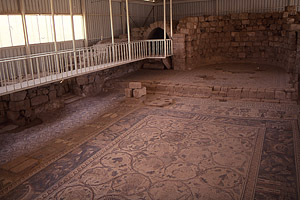
(Umm ar-Rasas, Madaba, Jordan)
Despite walking to the top of a neighboring bump to see a fraction more of the Dead Sea it was still pretty early in the day when we caught the bus back to Madaba. We decided that we did not want to spend the rest of our time lounging around in Madaba and so set off into the countryside once more. Our target was a small village called Umm ar-Rasas which sported yet another mosaic church. We found the bus very easily and surprisingly it was full and leaving straight away. The journey was very nice, the road winding its way through wadis and over hills and after about an hour we came to a dusty little village in the midst of the arid plains. We were dropped off at the end of a row of houses and, trusting in our guidebook, we started along a track into the middle of nowhere.
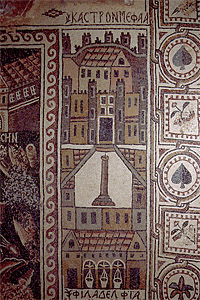
(Umm ar-Rasas, Madaba, Jordan)
It was in the middle of nowhere that we found what we were looking for. A two metre square stone tower about fifteen metres high. No one knows why it was built or by who, the best theory is that it was for a stylite. It is however important enough to be depicted in a representation of the town in the church's mosaic. It was to the church, about a kilometre away that we next headed. Next to the protective housing of the church's ruins there was a small hut and in this hut had been stationed two "guardians" one a policeman the other presumably an employee of the ministry of tourism. The only other things in the hut were a steel framed bed, a couple of bottles of water and about a thousand flies. The two guys looked bored to tears and vaguely surprised to see us. They waved us towards the mosaic and after about five minutes followed us in. The mosaic was again beautiful but this time was desperately in need of sweeping. It featured pictorial representations of all the big cities as well as animals and the four seasons. Sadly the later two had been mostly erased by the hands of the iconoclasts.
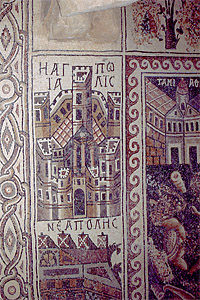
(Madaba, Jordan)
Back out on the road again the chance that a bus would turn up seemed slim. We waited for a while outside and then in the post office. We tried hitching but nobody was going very far. In the end we flagged down a private minibus going our way after about an hour's wait. The driver of the minibus turned out to be yet another archaeologist, this time Swiss. Moreover he happened to be one of the team that had unearthed the mosaic we had just seen. He had worked in Jordan for the last six years and now was doing a survey of the condition of all the sites unearthed in the region. He was a mine of information and he told us a bit about the problem he was trying to solve. Apparently the whole region has been populated then totally abandoned in a repeating cycle throughout the millennia. The most recent cycle started in the forties when the region was pretty much uninhabited. No evidence has appeared to link these cycles with the weather, even though the region's rainfall borders on the limit for sustaining agriculture. The most likely theory is that it is related to the wealth of the regime in power i.e. it is only in times of plenty that it becomes profitable to farm this semi-arid plateau.
The Swiss guy was nice enough to drop us off at our hotel and we strolled in to find it overrun by its own group of resident archaeologists cataloguing the day's findings. We sat outside for a while reading and writing and then went into town for what was perhaps the best Arab Cuisine we had encountered so far at not outrageously high prices.
Monday, 12 July 1999
Karak, Jordan
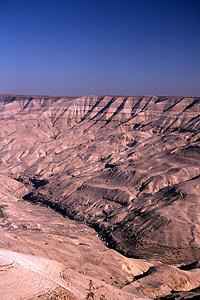
(Karak, Jordan)
The King's Highway - as the mountain road running from Madaba to Petra is known - is not the easiest road to travel on. Numerous changes of bus are required and there are even two sections where the buses run out entirely and you have to fend for yourself. Wadi Mujib, a huge canyon which forms the boundary between Madaba and Kerak counties is the first such no-man's land. Fortunately the locals are well aware of the situation and hang around in taxis with the express purpose of driving you a few kilometres for an exorbitant sum of money. One benefit of this however is that you can stop the driver in order to take pictures of the Wadi which is magnificent. Sadly when we got to the Wadi floor the threatened dam project looked well underway and set to ruin the unique environment within the canyon.
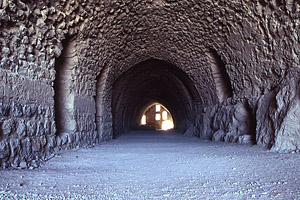
(Karak, Jordan)
At the other side people pretended to us that we had missed the only bus and that we would have to get a taxi. Fortunately within half an hour another bus turned up and we were on our way to Kerak. It is difficult to say much about the King's Highway. We were using the route mainly because we wanted to see more of Jordan than just the Desert Highway. However all we really saw was glimpses of arid farmland through the window, the odd oleander filled wadi and Karak. Now Karak as a town is very impressive, a town built virtually on a pinnacle of land with deep Wadis running either side. However it was some of the people within the confines of its walls that failed to impress us. Whereas in the rest of Jordan people had been friendly and honest in Kerak men constantly leered at Anna and made passing comments in Arabic, nobody said "Hello" and shopkeepers and restaurant owners seemed to think they could get away with charging us anything. It may have been as a result of being so close to the much richer Petra but whatever it was we did not really feel welcome in Karak and the people themselves did not seem to be to happy being there either. It came as no surprise to me to read that it was here that mass rioting began when the government removed subsidies on the price of bread.
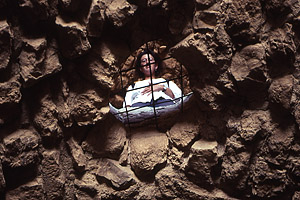
(Karak, Jordan)
Karak's attraction however is its crusader castle. It is not as well preserved as the Crac des Chevaliers and indeed once you get inside you wonder how you are going to spend more than half an hour there since all that seems to remain is a weed and rubble strewn hill. However this rubble is only the crumbled remains of the upper levels of the castle and below it several of the lower levels still survive. Dotted around the hill are a few cavernous holes with stairs leading down into them and once you descend you find yourself in a labyrinth of vaulted corridors and chambers. We explored for about an hour and we were pretty sure we did not see everything. After the castle we mooched for the rest of the day and wondered to ourselves why we had bothered to stop in Karak and not just carried straight on to Dana National Park.
Tuesday, 13 July 1999
Dana, Tafilah, Jordan
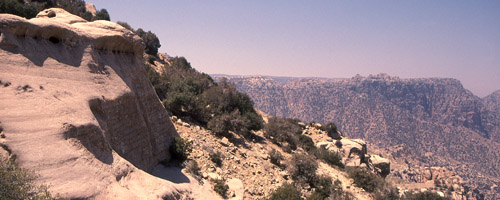
(Dana, Tafilah, Jordan)
We started off as early as possible again having to ignore people telling us to get in their taxi since we had missed the bus. We drove through the morning mist which made the strange, eroded rocky landscape seem that much more unreal. We changed buses once and were dropped at the top of the slope which leads down to Dana village and the massive canyons surrounding it. We hitched a lift down and pretty soon the village itself came into sight, a warren of stone buildings perched on the edge of a huge canyon of pink granite and white limestone. The thing that most caught our eye however was the greenery. Despite it being the height of summer the slopes were liberally dotted with trees and bushes and the area immediately around Dana itself was like an oasis of fruit trees and cypresses. I wondered how many wadis would be like this if they were not so destructively grazed by sheep and goats.
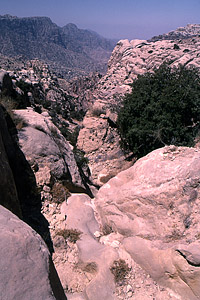
(Dana, Tafilah, Jordan)
Dana Biosphere Reserve is Jordan's biggest national park and because of this you can respect their decision to not allow you to take your own tent in and camp wherever you want. What is hard to fathom however is why they charge 7JD per person plus 5JD for the hire of the tent at their permanent campsites. It meant that the two of us would have been paying 19JD (almost £20) just to sleep in a tent. With 10JD entry on top we decided that living in the wilds was a bit too pricey for us and opted to stay in the village and just spend the day walking around.
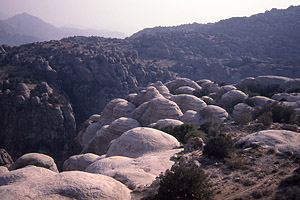
(Dana, Tafilah, Jordan)
The man in the tourist office in Dana, as well as telling us the prices for camping, had also insisted we needed the services of their underemployed guide to find our way around the reserve. We insisted that we did not and all they had to do was point us in the right direction. We won in the end and pretty soon we found ourselves walking along a tree lined path with only the sounds of birds and water running in the irrigation channel beside us to distract us. We had decided to walk to the Rumana campsite and back which would take us about three hours each way. It was a very dramatic path, every so often we would have to loop around gullies where the winter floods had cut deep gashes in the rock. The formations of the eroded rocks became increasingly more bizarre, one area that we spent time exploring on the way back was like a Guilin in minature.
At the Rumana campsite we avoided the tents and skirted around to some rocks above a grassy plain to have lunch and a short rest. We were just snoozing off when someone ran up to us. It was the manager of the campsite and it turned out that the people back at the information office had interpreted our walking towards the campsite as a desire to stay there despite us telling them that it was too expensive. We found it hard to convince the manager that what he had been told over the radio was wrong and since he kept going on about how nice his campsite was we did not have the heart to tell him exactly why we were not staying there. In the end he got the message and we relaxed with him and the other guys working at the empty campsite before setting off up Jebel Rumana, the small hill above us.
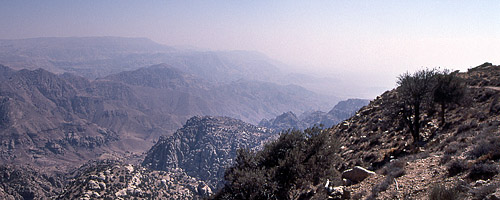
(Dana, Tafilah, Jordan)
The top of the hill rewarded us with a very hazy view of the Negev desert in the south of Israel on the opposite side of the Wadi Araba, into which Dana's wadis drain. It took us about an hour to go up and get back down, after which we had tea with the bored campsite staff and then returned to Dana. The sun was low in the sky by this time and lit up the walls of the Wadi with a golden light. Some sort of hawks or eagles whirled around in the hazy air riding the thermals coming off the hot, sheer walls of the canyon. When we got back to the village we went to report our return and sat on the terrace of another rest house and had an expensive apricot juice with the guy from the tourist office. He invited us for tea later which, being free, we thought was a bit out of character. It turned out that there was a film crew making a documentary about Dana and they wanted some footage of tourists, naturally we turned it down.
Wednesday, 14 July 1999
Petra, Aqaba, Jordan
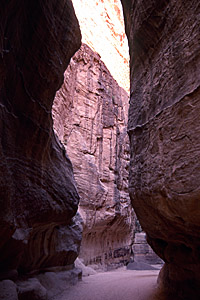
(Petra, Aqaba, Jordan)
We were not the only westerners in Dana. Back at our hotel we had met an Australian called Dino and spent most of the night chatting to him. First thing in the morning we all got up and made a start on the difficult journey to Petra. Step one, getting up the hill to the main road was the first problem as there was nobody around. We decided to walk it which with our full packs was tough going, fortunately the sun had not risen yet so it was mercifully cool. Step two, getting to the next town on the King's Highway Shawbak looked to be even harder since there was no sign of the buses that were rumoured to exist. We thought our luck was in when a fourth westerner came up from Dana in a pick-up chatting to the occupants in arabic, however she was as uninformed as us. Nevertheless she was able to tell us a bit more about Dana as she was a US Peace Corps volunteer assigned to the park's administration.
It was a curious tale as it turned out that the park had not asked for a volunteer and she had been foisted on them by the upper echelons of government. More than this because she was a woman everyone working there refused to take any of her advice and her boss had already tried to sack her but failed since it was a decision of one of her seniors. Her arabic had been learnt at a three month crash course with other volunteers in a village in Jordan but this had hardly prepared her for life in Dana. She lived with a family but despite this was not trusted by the community. She was, of course, modestly dressed but still was regarded as morally backward and had been advised by the women of the village not to talk to any men apart from at work where it was unavoidable. I found it all very odd especially as she told us that one of the aims of the US Peace Corps is to slowly Westernise developing countries. It was difficult to see how her being placed in such a community was helping the process and I know that if I were her I would be as miserable as hell. Nevertheless she approached the whole thing with a cheery optimism.
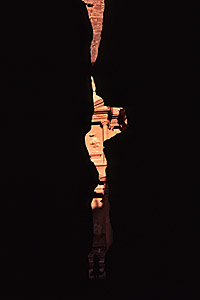
(Petra, Aqaba, Jordan)
Optimism coincidentally was a necessary quality for anyone wanting to travel on buses at the Southern end of the King's highway. In fact it became clearer and clearer that we were going nowhere fast. Eventually a brief conversation in arabic revealed that today was in fact election day and for some reason this meant there would be no buses going anywhere. We decided in the end to resort to taxis and so parted company with the Peace Corp worker. Everything was much quicker, and more expensive, from this point on and we finally got to Wadi Musa, the collection of hotels next to Petra, about nine. We found an excellent hotel on the slopes above Wadi Musa, sat around, had lunch and then said goodbye to Dino, who had decided to watch Lawrence of Arabia, before heading off to have a late afternoon walk around Petra.
The approach to Petra fires your anticipation to a level a hundred times that produced by the Inca Trail. The way in for ninety-nine percent of tourists is the "Siq", an unbelievably narrow winding canyon through a mountain which has been worn smooth over the millennia by the Musa river. The polished sandstone walls rise over a hundred metres above you and contain an amazing array of colours: white, red, yellow, orange, brown, black etc. To one side a water channel runs the entire length of the Siq, part of an irrigation system designed by the Nabateans to supply Petra with water throughout the year. You know from the thousands of pictures (and an "Indiana Jones" movie!) that pretty soon you are going to be staring face to face at the facade of the Treasury but you do not know when. When you round the final corner it completely takes your breath away.
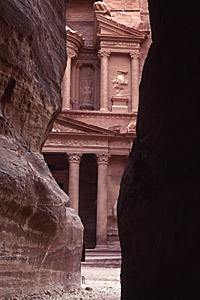
(Petra, Aqaba, Jordan)
To understand how unique Nabatean monuments look you just have to think about how they are constructed. Rather than quarrying a series of blocks and pillars and then fitting them together, the Nabateans, who basically lived in their quarry, cut out rock from the mountains to leave the pillars and walls. It is in effect the reverse of building. It is sculpture but the subject of the sculpture is the front of a building something which is usually constructed in a "positive" fashion. This is just a theory to try and explain why Petra's monuments seem so odd at first, but it could be for a hundred reasons, the proportions or just the whole idea that someone would ever bother to do this in the first place.
Anyway you first catch sight of Al Khazneh The Treasury from the Siq and a little while after you exit the narrow confines into the "clearing" one wall of which is occupied by the Treasury. Here we stared at it for a while and then climbed up a small side valley, double-backed and found ourselves on a platform at eye-level to the upper levels of the Treasury, far above the crowds. It was a bit of an unofficial route and on the way down people gawped at us and asked if they could go up that way too. This I guess was the first moment when I got a feel for what people miss when they come to Petra for a day or two. The Nabateans literally worshipped the rock, they lived in it, they stored their water in it but above all they climbed all over it. So in order to see and understand Petra you have to climb all over it too.
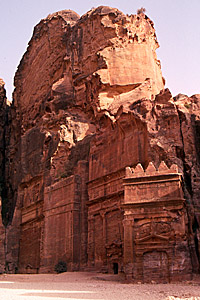
(Petra, Aqaba, Jordan)
Well that first afternoon there was not too much time for climbing. In fact all we managed to do was progress from the Treasury to the theatre, the "Street of Facades", a massive collection of carved tombs and finally the Cardo Maximus. You can get an idea of how big the place is when you realise that it takes an hour to walk from the entrance gate to the end of the Cardo Maximus. This is an hour of nothing but walking, we were looking around that first day and it took us more like two hours. Afterwards we were to realise that this walk takes you past a fraction of what Petra has to offer, it takes eight to ten hours to see all the highlights and even then you have missed a lot.
On a slightly more down to earth note when we exited Petra around six we went to wait for the hotel bus outside the luxury Mövenpick hotel. Waiting outside we made an earth shattering discovery, that the Mövenpick has the most amazing ice-cream parlour whose blackberry ice cream was so good that we went back there almost every day. After this we went back to the hotel, had dinner and fell almost straight to sleep in anticipation of a very long next day.
Thursday, 15 July 1999
Petra, Aqaba, Jordan

(Petra, Aqaba, Jordan)
We got up relatively early that morning and went in via the Siq again. Apparently there are two times to take photographs of the Treasury, in the morning hen the light strikes it directly and around six when light hits the rocks opposite and the reflected light bathes it in a warm glow. I decided that morning that the evening was better, in the morning the contrast is too high, I will have to wait until the pictures are developed to see if I was right.
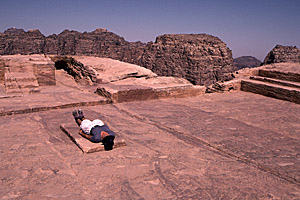
(Petra, Aqaba, Jordan)
After the Treasury we followed a staircase up through the rocks to what is called a "High Place of Sacrifice". Several mountains loom above Petra city centre and from what we saw on the top of each of them the Nabateans flattened off a rock and then carved into it a sacrificial pit. The first one we visited is about the easiest to get too and also the most extensive with several pits, carved rock needle and tons of ledges with views in every direction. Up on these "High Places" you get that feeling that anyone who has ever spent any time climbing hills and mountains will be familiar with. That sort of exposed, elemental feeling. From up high man's achievements are hardly visible and you start to see how small man is in relation to nature and as a result feel more affinity for the greater power. Again this is just an attempt to explain a feeling which I am sure a lot of people are familiar with, and those who are not should try getting it the first hand way instead of reading my ramblings.
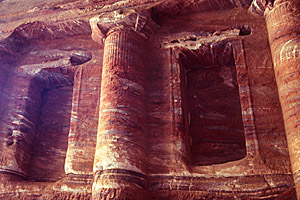
(Petra, Aqaba, Jordan)
From the high place you descend the other side of the mountain via a series of canyons carved with a collection of out-of-the-way tombs and tricliniums. Out of these I guess the most memorable was the triclinium opposite the Roman Soldier tomb which rather than just being a facade leading to a rather dull square room was a rather unnoticeable facade leading to a carved and polished interior. This is apparently pretty unique in Petra and it was interesting to see the multi-coloured banding of the polished walls in a subdued light.
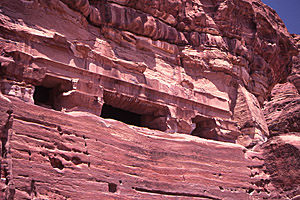
(Petra, Aqaba, Jordan)
We came off the mountain just behind what was apparently Petra's rubbish dump, a huge mountain of pottery shards, or looked at in another way a pile of free souvenirs. We rounded this and crossed the rock piles that were once the houses of the Nabateans to the other side of the city centre basin following a route above and parallel to the Cardo. On the mountains at the other side were a similar array of carved tomb facades. Of interest here was the so-called "Unfinished Tomb" which shows how they were carved, from the top down, I guess to give them something to stand on as they worked their way down the facade.
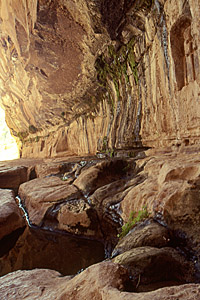
(Petra, Aqaba, Jordan)
After this we rested a while before setting off to the Monastery, Petra's second most famous facade. This involves another lengthy staircase fortunately a lot of which is shaded by the mountains rising above it. More fortunately our guide book had described a perfect place to stop for lunch on the way up and after a bit of searching around we found the correct staircase to get there. At the end of the staircase we found a perfect hiding hole from the sun, Qattar-ad-Dayr, where the rock face overhangs a spring and a wide ledge above a small oleander filled gully. Into the ledge the Nabateans cut a series of square pools in which the water slowly gathers. Two more facts conspire to make this place paradise: first no other tourist bothers to visit it so it is silent, secondly the silence is only ever broken by the sounds of birds who visit the spring to drink water from between the moss and ferns which line the spring. We stayed there for over an hour, reading after we had finished our lunch.
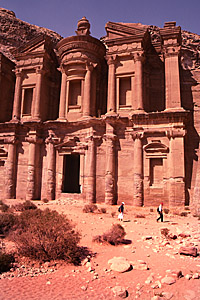
(Petra, Aqaba, Jordan)
From the spring it was about another half an hour's climb to the monastery. On the way we ran into Dino, the Australian guy, who was attempting to see everything in one day despite not being very well. He had done pretty much what we had but was now on his way down and in fact went back to the hotel soon after we left him completing a circuit of the major sites in about six or seven hours.
Again the moment when we first caught site of the Monastery was the most memorable. I think that you can never get a sense of how big something actually is from a two-dimensional photograph. This goes double for the Monastery because its design, the windows, the door etc. look perfect for a building a fraction of its size. The door is especially deceptive, you think that it is pretty normal until you actually get close to it and realise that the doorstep is as tall as you and you have to haul yourself up it in order to get inside. Unlike the Treasury it is carved out of a small hill and so is not covered at the top. However it does sport the same broken pediment and urn design used on the Treasury and quite a few other Nabatean monuments. Thus the urn at the top, which we are reliably informed is ten metres high, is the highest point of what used to be a hill and thus can be seen from a couple of high and not so high places a couple of kilometres away.
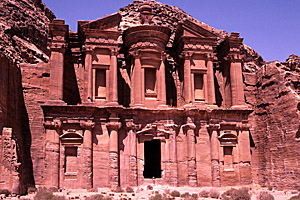
(Petra, Aqaba, Jordan)
From the Monastery you can take a short walk to a couple of ledges above a massive drop to a wadi bed below. From what we could see this marked the western boundary of Petra and beyond lies only mountains, Wadi Araba and the Israeli Negev desert. There is a path through these mountains somewhere that leads to the coast but we could not see it. We then climbed a small peak overlooking the Monastery. As with every centimetre of rock in Petra we found more carved chambers, symbols and stairs. We sat for a while taking in the view then made our way down.
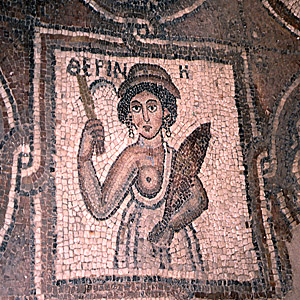
(Petra, Aqaba, Jordan)
On the way back we conspired to pass by the mosaics. In Petra's later years of Roman rule it was converted to Christianity and as well as converting one of the tombs into a cathedral a couple of churches were built. The ruins of one of these churches, complete with mosaic, were discovered whilst sifting through the rubble strewn hills and since Petra was abandoned before the iconoclasts got underway all of its animals and seasons have survived. Sadly it was closed but the modern encircling wall was just low enough for us to pull ourselves up and have a peek.
We were in a bit of a sad state finances wise by this point having not seen a cash point since Amman. We were down to our last ten dinar note and so were forced to have a very meagre dinner of Shwarma kebabs at an establishment just down the road. We were not sure how the situation was going to resolve itself because it was now Thursday night and everything is closed on Friday... we would have to live on credit for a while.
Friday, 16 July 1999
Petra, Aqaba, Jordan
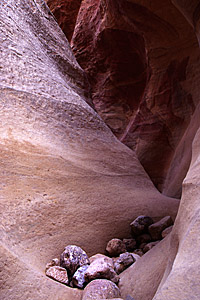
(Petra, Aqaba, Jordan)
I said before that 99% of tourists enter Petra by the Siq only. Today we had decided to become part of the privileged 1% and enter by the Wadi Muthlim. Just before the entrance to the Siq a dam has been constructed (replacing a ruined Nabatean dam) that redirects the waters of the Wadi Musa through a tunnel into the Wadi Muthlim. In this way the Nabateans kept the Siq free from water all year round without wasting the water as the Wadi Muthlim is a tributary of a river which flows into Petra city centre. Thus by flowing this water detour in summer, when there is no water at all, you can get into Petra via an alternative route. After the tunnel you find yourself walking along the bed of a not so narrow and not so deep canyon and you wonder whether the Siq would not have been cooler. Then after half an hour of squeezing past rocks and oleander bushes you realise that its not so wide after all, eventually you arrive at a T-junction and enter a siq (small 's') that is more like a tunnel through the heart of a mountain.
This section, although it is only a couple of hundred metres long is the one that takes your breath away. The water, as it snakes its way through the heart of the mountain has worn the multi-coloured rock completely smooth. Also completely smooth are the few boulders that have gathered in the bowls on the bottom of the siq like stones in the gullet of a bird. It was an amazing place for a photograph but of course there was not a single flat surface to rest the tripod on and it took me five minutes of fiddling around before I had it balanced against the curved tunnel wall. Further on the swirling waters had ground out a circular chamber about two metres in diameter. The Nabateans clearly thought this place to have a special significance and all sorts of symbols and features had been carved in relief on the walls. We rested here for a while before emerging into the open valley of the Wadi Mataha which would take us into the centre of Petra.
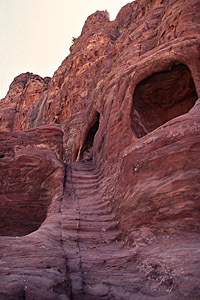
(Petra, Aqaba, Jordan)
The mountain on the east side of the Wadi Mataha had also been modified but for a different purpose. Huge chambers formed primitive houses which had been refined over the years. Windows had been cut, the insides squared off and polished etc. to form pretty comfortable houses. Although we had no information about these houses it seemed pretty clear that we were looking at the great-great-grandfathers of the Treasury. The Nabateans had started off living in caves and though after exposure to Hellenic and Roman culture they started to build houses they adapted their skills to scoop magnificent monuments out of the rock instead. The Nabateans were a very adaptable race, they moved from robbing caravans to providing safe passage for them and blended the cultures and religions of the merchants with their own. Although you can see the Roman and Hellenic influences in their monuments they never lost their attachment to the rocks which they worshipped.
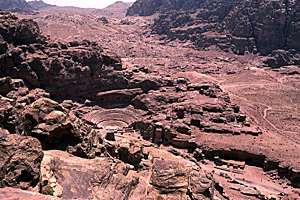
(Petra, Aqaba, Jordan)
A little way around from these houses the tombs of the East cliff start. Almost hidden behind some huge oleanders the Carmine tomb was a badly weathered riot of colours. On from this was the tomb of Sextus Florentius, a Roman who so liked Petra that he arranged to be buried there instead of his native Rome. However in between these two tombs was a large gully one side of which had a massive staircase hewn out of it. It was time to go up again. Fortunately the staircase had recently been restored and it was pretty easy going. We exited the gully after a while but continued up and round. Eventually we found ourselves on a ledge and looking down we were amazed to see that we were above the theatre. In fact so far above that with its concentric rings it just looked like a quarter of an onion. Further along the ridge we came to a small structure and another sacrificial pit carved out of the rock. We looked at Petra from this High Place for a while, had some breakfast and then wondered what to do.
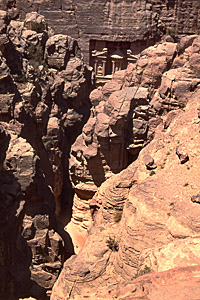
(Petra, Aqaba, Jordan)
Paths led off everywhere so I picked one that roughly went towards the Siq in the hope that we would get a top view without falling in. We crossed a saddle and found ourselves in a small grazing area then pushed our way down a very narrow gap to another small plateau where we found some cairns to follow. Eventually we emerged into an area of domed rocks and a bit of scrambling got us the view we wanted. In fact we got more than we bargained for because we could also see the top of a tomb. It took us a while but suddenly we realised that this was the Treasury! From so far up it looked tiny. We moved onto another dome and from there were able to also see one of the more open parts of the Siq and in it all the lazy tourists who should have been entering the site three hours before.
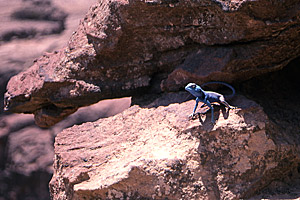
(Petra, Aqaba, Jordan)
It was whilst scrambling between the domes that we had a bit of luck photograph-wise. In Dana Anna and caught a glimpse of a turquoise lizard and in various places in Petra we had seen partially blue lizards. I was coming down a slope when I saw a fully blue specimen sitting on the red rocks. I realised that by circling around slowly I could get a picture of it. This I did getting within twenty centimetres. It did not notice me at all, I seem to remember reading somewhere that their visual system is adapted to fast moving objects and so they cannot see you if you move slowly. It jumped slightly at the sound of the shutter but I was able to get two shots. It puzzled us why it was blue but we came up with an explanation - they must have been chameleons of some sort, turning blue in the night and changing to a more sensible colour when they emerged into the morning sun. This could maybe explain why we saw some with just a blue head or tail. We could not believe that blue was their full time colour, it would make them ridiculously easy to spot.
After this it was time for lunch, we found a small overhang and when this proved inadequate we located a tree and fell asleep under it thus avoiding the worst of the heat. It was strange but the mountains were full of trees and small grazing areas connected by staircases. It appeared that the Nabateans, or maybe the mountain dwelling Edomites before them, had built tiny dams so that gullies were turned into small lakes in the winter and gradually filled up with soil. If this was true then the Nabateans really were one with the mountain, not only did they live in it, they collected every drop of water that fell on it and grazed their animals on artificial pastures. Although they later made a life from caravans it was clear that they had originally gotten everything they needed from what appears at first to be a barren chunk of red rock.
We descended to the city centre then went to the museum. This proved less than edifying on the areas of Nabatean engineering that I was interested in but there were some nice pots! We sweated for a bit in the shade outside the museum then decided to make a beeline for the Snake Monument. One thing I had learned from the museum was that only the privileged ever got into the heart of Petra. Around the periphery were several suburbs where goods coming in from each of the four directions would be traded. It appeared that the merchants operated an extremely sophisticated trading system and that the dirty work was done in the suburbs and coordinated by the fat merchants living in the centre. We decided to walk part of the way to the southern suburb Sabra to what is known as the Snake Monument.
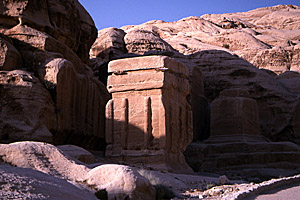
(Petra, Aqaba, Jordan)
In the end it was hardly worth it. The valley we were walking along may have been full of houses in its heyday but was now very boring, hot and dusty. When we got there the "Snake" turned out to be barely recognisable and worst of all some kids attempted to hustle us. his little girl followed us the last 500m to the monument pretending to be trying to make friends but when we got back down again she turned on us asking for 1JD for being our guide. When we refused her brother stepped out of the rocks and told us it was a ticket. It was sad and the worst thing was that it looked like they had nothing to do with the handful of Bdul who still lived on in the caves here. It seemed like they had positioned themselves to take advantage of the odd tourist that made the effort of escaping the lightly policed city centre. I have not really mentioned the people pushing horse and camel rides and transport up to the high places by donkey. Of course it seemed cruel and pointless but Petra is really one of these places where the usual rubbish fades into the background. I guess the only reason the eight year old hustlers stood out in my memory was because the Snake Monument really was not much to look at.
We had dinner in the hotel that night and for company had the son and nice of a Dutch UN Golan Heights Observer. The older generation were in one of the bigger hotels and the younger in ours. It was an okay conversation, the only problem being that they suffered from a lack of things to say, although they did much better than I would have at their age. Afterwards we all watched the first Austin Powers movie. The only truly guffaw provoking moment was when Austin does a striptease to the tune of "I touch myself". Frankly your average Sean Connery Bond Movie has funnier lines.
Saturday, 17 July 1999
Petra, Aqaba, Jordan
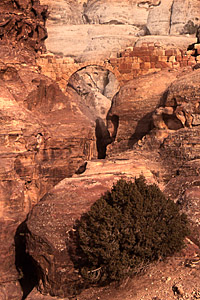
(Petra, Aqaba, Jordan)
Our lack of cash situation had not improved by this point. We wanted to leave the next day so we had to get some cash that morning. The trouble was, as we found out, banks are on holiday in Jordan on both Friday and Saturday. There was one bank open so we had no choice but to accept the 3% commission he charged. We then slobbed around, had lunch, tried to provision ourselves for Wadi Rum etc. The hotel then tried to twist our arm into going to see so called "Little Petra", the northern suburb of Petra, but it seemed pointless to pay large amounts of money for a taxi when we already had paid to get into "Big Petra". We finally set off at four, about the time it starts to cool down. Again we decided to go in via Wadi Muthlim, there are other ways in but it was too late in the day to contemplate anything new.
After the "tunnel" we turned right instead of left towards the city centre and climbed the rocks to a point above the siq we had just exited. We were following vague instructions to get to a Nabatean aqueduct. In fact getting lost a few times on the way paid off big time. The first dead end we got to was at a Nabatean cistern, it was like so many of the caves we had seen except the floor was ten metres below the entrance. Further on up we found channels which eventually drained into the cistern. The channels were amazing because they contoured the rock exactly and I guess in this way they gather not only water from gullies but any water falling on the rocks above the channel. One thing that was especially interesting for us was that it was not the first time we had seen such channels. In Pakistan the people of the Hunza valley had also used rock cut channels to bring water from kilometres away. Maybe it is something completely obvious and two civilisations could come up with the same thing independently. However I like to believe that, as with the water wheels in Syria and China, it is the Silk Road at work again.
We were just wondering if we were really lost when we suddenly spotted the aqueduct. In the late afternoon sun it was a vision of perfection. Perched above an infinitely deep looking siq it was a simple arch of stones with a channel perched on its apex. It looked as if it would fall over in the wind but it had survived the centuries intact. I say it time and time again but I hope that the photographs do it justice. We did not stay for long but it made me wonder how many amazing sights Petra can possibly offer, if we stayed for a week more would we still discover something new every day?
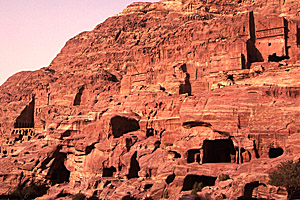
(Petra, Aqaba, Jordan)
In all the time we were in Petra we had never investigated the main tombs of the East Cliff. So on this, our last day, we decided to see what had been hidden behind crowds of tourists all those days. The answer was in fact not much. As was usual in Petra the ornate facades always lead on to plain, box like rooms. The room behind the Urn Tomb was potentially a bit more interesting as it had served as Petra's Cathedral. However since the only evidence of this is some holes in the floor and some inscriptions on the wall we were left with nothing more exciting than the echo that could be achieved. What we did find interesting was that with a bit of courage we could work our way upwards to one side of the Urn tomb to a point where we were almost above the facades of another group of tombs. We stopped short in the end because we had a crisis of conscience about climbing over such an important part of Petra. Later on we discovered that we could have gone up and over and would have come out safe and sound just before the west entrance of the Siq.
And that was about it for Petra, we watched the start of the sunset but sadly the sun disappeared behind a mountain instead of slotting in a gap between mountains and we did not get a really burning red or the famous "pink". Whatever colour we were sorry to say goodbye to it as we had felt really at home there. We had already missed the hotel's bus back so instead we ate at one of the pizza joints near the entrance. We caught a taxi back and just as we arrived someone was putting "Indiana Jones and the Last Crusade" on for the millionth time so we sat and watched it with everyone. The owner of the hotel dished out yoghurt for everyone and we sat and ate it watching the movie like one big happy family....
Sunday, 18 July 1999
Wadi Rum, Aqaba, Jordan
Well after Petra it was hard to see how anything could match up. We had long planned that in Wadi Rum we would do lots of walking and had bought a special pamphlet on walks written by an English climber invited over for that purpose by the Jordanians. So to then walk into the government run rest house, ask "Where do we leave our rucksacks?" and be answered "you can't" was a bit of a letdown. As sad as I am to say it the place had become a bit of a tourist trap. We decided to camp at the back of the rest house and do a couple of short walks that day which gave us an opportunity to observe the set up. Next to the rest house, officially the only place to stay, there was a huge parking lot. In this parking lot was a queue of jeep drivers. The tourist office would effectively group people together and then assign them the next jeep and the jeep would then take you on a predetermined route around the spectacular hills of Rum. The only buses anywhere left in the morning so if you did not want to take a taxi to the highway you had no choice but to take a jeep trip, eat in the rest house, stay in the rest house tents then leave on a bus that charged tourist prices.
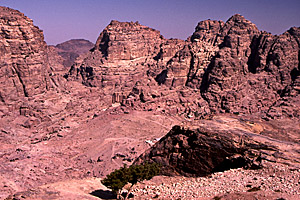
(Wadi Rum, Aqaba, Jordan)
It was hardly surprising considering the set-up that when we announced we wanted to walk to Lawrence's Well people started looking at us in amazement. "No ride camel?" they despondently asked us. The walk was barely three quarters of an hour. We walked a short way through the desert then scrambled up a rocky slope then traversed around the base of the cliffs of Jebel Rum. Here there were many springs, little oases usually with one huge tree and several bushes tumbling down the slopes. One of the plants that seems to flourish around the springs is some sort of mint which fills the air with a wonderful fresh smell. There was no water gushing out of any of them, if you were lucky you could make out the odd drip. Not so with Lawrence's well when we found, it was like a minature waterfall from which we were able to fill our water carrier in a very short space of time. The only problem was that whereas Lawrence had found a "piece of paradise just five foot square" we had found a concrete bunker five feet square. The locals were using the spring as part of the town's water supply and so had enclosed it with walls. Worse than this the surrounding area was covered in litter. We did not stop for long preferring to walk along the base of the cliffs a little more to a much more pleasant spot from which to contemplate the surrounding mountains.
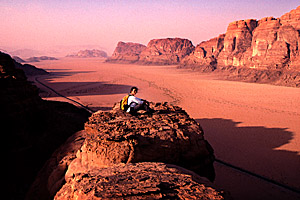
(Wadi Rum, Aqaba, Jordan)
We spent the hot part of the day in the sort of Bedouin tent arrangement at the back of the hotel. I chatted for a while with an American guy on his way to Petra for a second look and told him about the Wadi Muthlim entry route. When it was finally a fraction cooler than unbearably hot we went out for a second short walk. This one involved climbing directly up the hill behind the rest house, a small spur of the Jebel Rum massif and then slowly making our way up to a small peak. We used our special walking book which helped us to get up a lot further than we would if we were left to our own devices as it mapped out the easiest routes. We decided not to make an assault on the summit as the scrambling involved looked a little too much like rock climbing to us and instead found a flat ledge. The mountains of Petra and Wadi Rum were full of such ledges, often they were topped by a small layer of a harder rock. In this case it was a basalt like substance that had cracked in such a way that it looked like someone had purposefully tile the ledge. From this dramatic little eerie we had a terrific view over Wadi Rum and of the surrounding mountains.
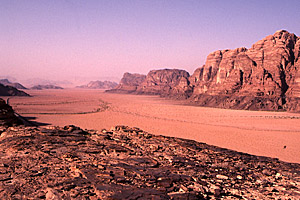
(Wadi Rum, Aqaba, Jordan)
When I think back of this view it is with a slight sense of sadness. The problem in Wadi Rum was not that we did not have anywhere to store the luggage, although this did not make life easy, it was that we had just come from four days of sweaty walking around Petra. What we really thirsted after was "Aqaba!" and the cool sea. In this light the bone dry mountains around Wadi Rum really were the last thing we needed. If we had been a bit more intelligent we could have swapped things around a little as Aqaba and Wadi Rum are very close and it would not have hurt to have gone to Aqaba twice. Anyway I can certainly see us going back to Petra some time in the future and when we do I think a more extensive poke around Wadi Rum will be on the cards.
It was pretty challenging getting back from our lofty perch. The book described a possible exit route down a gully which was fine but it was full of loose rocks and at one point we had to lower ourselves down a vertical drop of just under two metres. We got back to our tent just as the sunset was about to stop lighting the mountain opposite with a warm red glow, had dinner then slept.
Monday, 19 July 1999
Wadi Rum, Aqaba, Jordan
"When in Rum do as the Rum-ans do!" We had decided to conform and hire a jeep for the day. It was out of a realisation that we were never going to strike out on our own for a couple of days - even if we had the will we would not have enough water. Not liking the idea of camels that basically left us with one choice, a jeep tour. We hung around the rest house at breakfast and eventually found someone to split the cost with, a Dutch couple travelling with their son. Our efforts to hire a jeep for the day did not go well, the Dutch woman had been doing some shopping when she was approached by a boy who offered her a jeep for the day at a price slightly under the recommended government rate. We went to see the jeep and everything looked above board except that the guy said we would have to walk a little out of town before he could legally pick us up. Not liking the tightly controlled nature of the system in Rum we agreed but as we were walking out of town we were virtually arrested by the police and taken back to the rest house.
This got us more than a bit upset, if they wanted to control things this much they should really be arresting the unlicensed drivers, not the tourists we complained. Anyway we were assigned a pick-up and driver and it did not take me too long to notice that unlike the pair we had found ourselves this driver did not speak English well and his pick-up was only two wheel drive. Assuming these to be bare essentials of a desert tour I collared the bastard who was running the show. "You do not need four wheel drive, it has a very high gear", was the response. Assuming it to be the standard run-of-the-mill Nissan pick-up it looked like I replied "You mean it has first gear?". "No it has even better than first gear". I abandoned all hope of getting any sense out of this moron. I knew if we insisted on a four-wheel drive that the only way we would ever get one was out of vengeance, we would end up in a jeep with a malfunctioning four wheel drive or with a driver who would refuse to use it on the grounds that it would use too much petrol. We just got in the back of the pick-up.
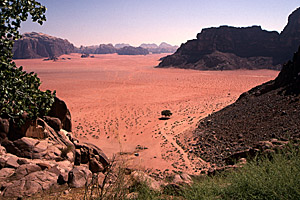
(Wadi Rum, Aqaba, Jordan)
We had been given a rough idea of what our itinerary would be: Lawrence's Well, Khazali Siq, small rock bridge, big rock bridge... But I had thought it was just that, a rough idea. We went to Lawrence's well which turned out to be a completely different spring from the one we had visited yesterday. Hardly surprising considering the unappealing nature of the original. What was surprising was that once we had scrambled for a quarter of an hour up to the substitute we found that it was no more than a stagnant puddle. We then were driven to a siq in one side of a rock known as Khazali. This was okay and quite fun even though you could not get more than a couple of hundred metres up it but what was a bit worrying was that we were by no means the only people there, some people were just coming out as we went in and three jeep loads arrived after us. It suddenly became crystal clear that what we had thought was a rough idea was in fact a fixed itinerary and everyone was doing the same.
We had an emergency conference with the driver. Although he could not string them together into a sentence he knew all of the names of the places in English. We had read that Barrah Canyon, a very narrow corridor between two mountains was a nice 5km walk so we asked him about it and he suggested that we skip the little rock bridge, go to the big rock bridge then drop us at one end of the canyon through which we would walk and meet him at the other end. This seemed an excellent suggestion and a good way of avoiding the impending crowds.
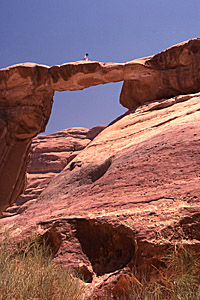
(Wadi Rum, Aqaba, Jordan)
The Jabal Umm Fruth Rock Bridge was admittedly very impressive. There are quite a few bridges and although Burdah is the biggest it is a good two hour climb from the valley floor. Umm Fruth is just a five minute scramble so a little more manageable. We did all the usual stuff getting each other to cross it so we could take pictures from below. We then all piled back into the car to head for Barrah. We had a puncture on the way and of course the driver did not have a jack so we basically had to lift the car onto some rocks! Finally we pulled to a stop in the middle of nowhere. The driver told us he could not go all the way to the entrance, his pick-up was not up to it apparently, instead he dropped us "near" it and gave us instructions assuring us that it was just around the corner.
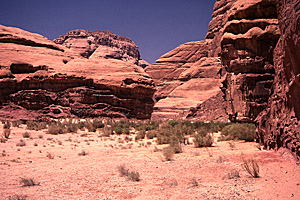
(Wadi Rum, Aqaba, Jordan)
It took us half an hour and a lot of interpretation of his instructions to find the entrance to the canyon. He had dropped us something like two kilometres away from it. I knew the walk through the canyon was five kilometres and so what we had thought would take us a bit over an hour was starting to look more like two. Worse than this we felt a bit guilty because the Dutch family, although game for anything were looking slightly annoyed with us. I will never be sure if they actually were because they put a brave face on the whole thing but you could tell they were slightly worried that we were lost in the desert. This was not helped by our rapidly waning confidence in our driver. "What if he got another flat?", "What if he got lost?", "What if we were in the wrong canyon?" we all wondered silently.
The canyon was indeed very beautiful, the rock took on some very bizarre forms and the going was pretty easy. There were a couple of times when it did a sharp turn that we were convinced we had reached a dead end finding the way forwards at practically the last moment. There was precious little shade and we hugged the cliffs whenever we could to avoid the burning heat. I guess in our way we got closer to a true desert experience than any of the other groups on the set itinerary. It is an interesting thing but the lack of water completely changes the nature of trekking. We had thought nothing about walking 120 kilometres in Patagonia and here we were desperately worried about a five kilometre walk barely twenty kilometres away from Rum village. Anyway to cut a long story short nobody died or had to drink their own urine. After two hours we stumbled out of the other side of the canyon and found our driver resting in the shade of a rock.
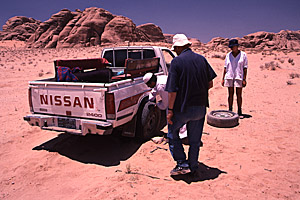
(Wadi Rum, Aqaba, Jordan)
We had lunch, the driver lit a fire (with our matches since he had none) and made some tea (which we took turns to drink since he only had three cups) and we had a brief siesta. When we were finally ready to go the driver announced that in parking he had run the pick-up onto a rock and it was now very much stuck. We gathered rocks, stuck them under the wheels to create a ramp to lift it off the big rock. The driver then revved up the engine, the wheels spun and ground the rock into sand. The whole affair lasted about half an hour until finally, with an amazing amount of pushing, rocking and lifting we got it unstuck. We drove off at a breakneck speed which I assumed was a tactic to avoid getting stuck and zoomed off to rejoin the regular tourist circuit at breakneck speed. After ten minutes the son of the Dutch couple realised his watch had fallen off during all the pushing and so we had to go back again. Things were not going well and the driver did not look a happy man.
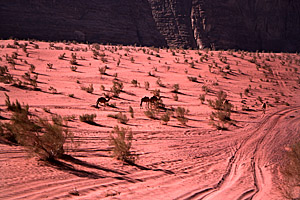
(Wadi Rum, Aqaba, Jordan)
To the north of Barrah was an area of rifting sand dunes. The technique for getting over sand dunes apparently is to drive very fast and hope the momentum would carry you over the top. Naturally enough it did not and we got stuck again. Used to the drill we got out and dug the car out for the driver. I was seriously regretting not making more of a fuss in the morning. All of this effort it turned out was to show us some crude petroglyphs that meant nothing to us since our guide's command of English was not good enough to pass on the years of academic study on the subject he had no doubt undertaken. Then we went to a big red sand dune.
Okay I guess a sand dune is something you could get excited about if you had never seen one. We had seen one but we did drum up the enthusiasm to walk half way up the crest then run down the side. We then sat around and argued with the driver. The Dutch family it appeared had run out of water, it was two hours before sunset, the final item on our tour, so it seemed reasonable to ask the driver to take us back to Rum village to pick up water before going on. We again felt a bit guilty since we had seen how little they had bought in the morning but had not said anything because we thought that our canny guide would know a thousand secret Bedouin springs. His response to the request was two-fold "I say in morning if you want anything from the shop" and "You want me to drive you to Saudi Arabia as well?" from which we took it that he refused. In the end we wanted to see the sunset so the Dutch family opted to go thirsty even though we offered them some of our water.
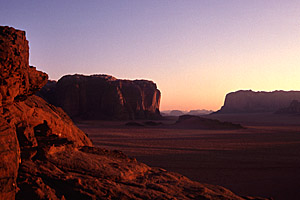
(Wadi Rum, Aqaba, Jordan)
The place we were taken to see the sunset was a small rocky outcrop suspiciously close to Rum and suspiciously devoid of other tourists (we got stuck in the sand on the way there but by now this seemed par for the course and seems hardly worth mentioning). Despite this we climbed to the top and found that we had a good view of the open desert beyond Wadi Rum. We did not get much of a sunset because before the final stages it popped behind a mountain. My suspicions were proved correct, he had basically driven us to the closest, rather than the best, point from which to see the proceedings. Pretty soon after the disappearance of the sun we descended to the pick-up and went back to the resthouse.
One interesting postscript to the story was that we met some backpackers on the ferry to Egypt two days later who had followed the predetermined itinerary. They had zipped through the list of desert highlights and been deposited at the sunset point four hours before sunset! It seemed that the jeep drivers, despite being hired on the day, were more keen to keep their petrol consumption down than they were to show people the beauty of the desert. The usual idea of a letter to the Lonely Planet was mooted but as usual we concluded what was the point.
Tuesday, 20 July 1999
Aqaba, Jordan
The Wadi Rum tourist machine did have one more trick up its sleeve. The bus to Aqaba leaves at seven but before it comes to the resthouse it does a tour of the village and picks up all the locals. This is fair enough but what happened next is a disgrace. Because the bus had so many locals on it only ten out of the fourteen backpackers waiting were allowed on it. Then the guy running the tourist office hops on and charges 1.5JD a head from the tourists only. For similar distances in the rest of Jordan we had paid a third of this. I would not have been surprised to find out that the locals go for free which would have been barely excusable if it was not for the fact that four tourists were basically left on the roadside. It was a shame because in the rest of Jordan the tourist offices are well run and helpful, in Wadi Rum the tourist officer was more like the don at the head of a local Mafia.
Enough of such complaints because it was that day we finally reached Aqaba! . We were forewarned that it is an oppressively hot place in the summer so once we had checked into a hotel we went straight to the beach. Although the Royal Diving School is ten kilometres out of town and costs 2JD to get in it is a pretty good place to head for. There is some excellent snorkeling just at the end of the jetty which takes you over the top of the reef flats, there is a swimming pool and the beach is guaranteed pervert free so women can wear bikinis without getting hassled. We rented masks and fins and popped our heads underwater. It was great but I will refrain from too many descriptions since with the Egyptian diving resorts our next destination I will have plenty of opportunity to wax lyrical about fish.
And that was about it for Jordan. We spent the day snorkeling, getting sunburnt and generally doing beach things. That night it was hot, almost thirty degrees and we did not spend too much time wandering around before we ran for the cover of our air conditioned room




